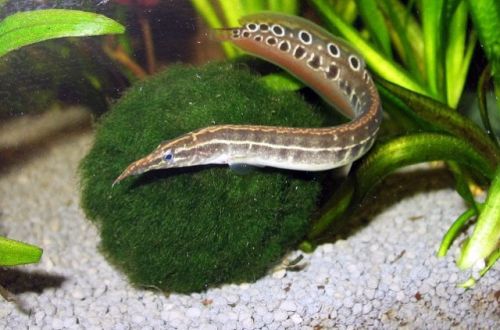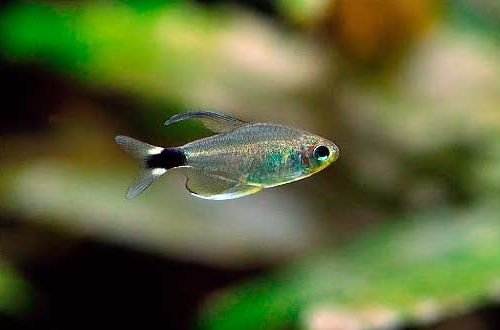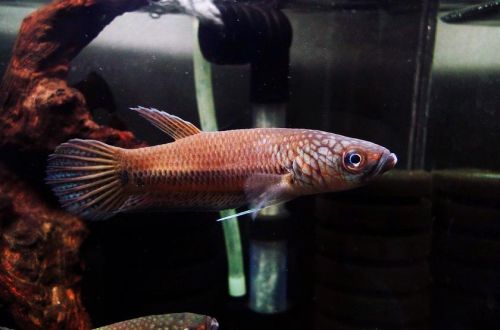
To Som-Korea
Snag catfish or Bunocephalus (Bunocephalus coracoideus) is a curious fish with an unusual body shape. Due to its appearance in Latin America, the catfish was called Guttarita (Guitarrita) because of the similarity with the musical instrument of the same name – a kind of guitar.

The official scientific name is Bunocephalus, derived from the Greek word “bounos”, meaning hill or hill, which characterizes the “bumpy” head of the fish. The catfish has a laterally compressed body, covered with horizontal rows of large horny protrusions. Its broad head and narrow body are just like a guitar in appearance.
The snag catfish is a peaceful fish and is suitable for any aquarium, compatible with all fish communities, even the smallest ones. Catfish can live both alone and in a group, leads a sedentary lifestyle.
Able to adapt to various conditions, is an excellent orderly aquarium. It feeds at night or in the twilight, the diet can include both special food for catfish and uneaten food leftovers left by other inhabitants.
Brief information
- The volume of the aquarium – from 80 liters
- Temperature – 20-28°C
- Value pH — 5.0–8.0
- Water hardness – soft to medium hard (5-19 dGH)
- Substrate type – coarse sand or sand-gravel mixture
- Lighting – subdued
- Brackish water – no
- Water movement – still water or light movement preferred
- The size of the fish is about 15 cm.
- Food – any sinking food
- Content alone or in a group
Contents
Habitat
The snag catfish (Bunocephalus coracoideus) was described by the explorer Cope in 1874 and can be found in some publications as Dysichthys coracoideus. There are several varieties of this fish, but they are all united under one common name. Initially it was believed that it comes from the reservoirs of Peru, but later the habitat was significantly expanded, finding it throughout the Amazon in Bolivia, Uruguay, Brazil, and even in Ecuador.
Catfish is common in small streams, ponds and lakes, which have a weak current or completely stagnant water. It lives in places of accumulation of natural debris – a sunken tree, shrubs, often hiding under fallen leaves. Omnivorous, enjoys eating plant debris. In the wild, it is found both singly and in groups.
Description
Adults reach a length of about 15 cm. A wide flattened head and a long thin body, laterally compressed and covered with horizontal rows of large wart-like outgrowths. The eyes are small and difficult to distinguish. The pectoral fins differ in size, the caudal fin is long, the catfish has a peculiarity – the absence of an adipose fin, which has atrophied in the course of evolution.
The small size and sedentary lifestyle make it vulnerable to many types of predators, to compensate for this, the catfish has acquired an effective camouflage that allows it to hide in its natural habitat.
Food
Able to eat a wide variety of foods, but prefers live food: bloodworms, small earthworms. It will also accept frozen foods, cereals, granules/tablets, and anything else that can sink to the bottom. An important feature is that these fish, as a rule, are nocturnal and do not come out to feed in the light.
Maintenance and care
Snag catfish do not require special maintenance. The only important condition is the weekly cleaning of the soil with a siphon to remove the decaying remains of food and plants, which are a source of free ammonia.
The recommended size of the aquarium is from 80 liters, the design must include shelters in the form of snags, grottoes, plants with wide bottom leaves. Around this kind of shelter, it is worth organizing free areas – feeding places, on which sinking food will fall. Since the fish are active at night, you can place an LED night light in the aquarium to watch your pet.
Water:
Once every two weeks, change 10-15% of the water from the volume of the tank.
Able to withstand pH fluctuations without compromising health
Behavior and Compatibility
It is the embodiment of a peaceful nature. It gets along well with many fish of comparable size and temperament. It should not be combined with noisy or aggressive fish, this can lead to sad consequences, both for this aggressor fish (may get injured on catfish spikes) and for catfish.
Breeding / breeding
Both sexes look the same. The female may appear slightly fuller. The catfish reaches sexual maturity at a body size of 11 cm. The pair prefers to spawn in shelters / caves with a sandy bottom, however, if there are only bare shelters, then the catfish can peel off the plants and cover the bottom with them.
Spawning usually takes place in the dark. The female lays a total of several hundred eggs over several nights. The couple guards the clutch until the fry hatch, however, to protect against other fish, it is recommended to remove the eggs from the main aquarium along with the female. After the appearance of the fry, the female is returned back. In the first days after the appearance of fry, they should be fed with specialized food or ordinary dry crushed flakes, granules.
fish diseases
The snag catfish (Bunocephalus coracoideus) is not susceptible to most diseases, provided the fish are kept in proper conditions and adapted correctly. Like other fish, it is very susceptible to ammonia, so periodic cleaning of the soil is crucial. To prevent diseases, we suggest that you familiarize yourself with the section “Diseases of aquarium fish”.
Features
- Feeds at night, feed after turning off the light
- Does not get along with aggressive predatory neighbors
- Eats snails and other invertebrates
- Catfish is able to pull out plants with a weak root system
- Sensitive to drugs





